- Home
- About
- Map
- Trips
- Bringing Boat West
- Migration West
- Solo Motorcycle Ride
- Final Family XC Trip
- Colorado Rockies
- Graduates' XC Trip
- Yosemite & Nevada
- Colorado & Utah
- Best of Utah
- Southern Loop
- Pacific Northwest
- Northern Loop
- Los Angeles to NYC
- East Coast Trips
- Martha's Vineyard
- 1 Week in Quebec
- Southeast Coast
- NH Backpacking
- Martha's Vineyard
- Canadian Maritimes
- Ocracoke Island
- Edisto Island
- First Landing '02
- Hunting Island '02
- Stowe in Winter
- Hunting Island '01
- Lake Placid
- Chesapeake
- Provincetown
- Hunting Island '00
- Acadia in Winter
- Boston Suburbs
- Niagara Falls
- First Landing '99
- Cape Hatteras
- West Coast Trips
- Burning Man
- Utah Off-Roading
- Maui
- Mojave 4WD Course
- Colorado River Rafting
- Bishop & Death Valley
- Kauai
- Yosemite Fall
- Utah Off-Road
- Lost Coast
- Yosemite Valley
- Arizona and New Mexico
- Pescadero & Capitola
- Bishop & Death Valley
- San Diego, Anza Borrego, Joshua Tree
- Carmel
- Death Valley in Fall
- Yosemite in the Fall
- Pacific Northwest
- Utah Off-Roading
- Southern CA Deserts
- Yosemite & Covid
- Lake Powell Covid
- Eastern Sierra & Covid
- Bishop & Death Valley
- Central & SE Oregon
- Mojave Road
- Eastern Sierra
- Trinity Alps
- Tuolumne Meadows
- Lake Powell Boating
- Eastern Sierra
- Yosemite Winter
- Hawaii
- 4WD Eastern Sierra
- 4WD Death Valley +
- Southern CA Deserts
- Christmas in Tahoe
- Yosemite & Pinnacles
- Totality
- Yosemite & Sierra
- Yosemite Christmas
- Yosemite, San Diego
- Yosemite & North CA
- Seattle to Sierra
- Southwest Deserts
- Yosemite & Sierra
- Pacific Northwest
- Yosemite & South CA
- Pacific Northwest
- Northern California
- Southern Alaska
- Vancouver Island
- International Trips
- Index
- Tips
- Books
- Photos/Videos
- Search
- Contact
Lucerne, Switzerland
Saturday, June 17, 2017 - 4:00pm by Lolo
55 miles and 1.5 hours from our last stop - 2 night stay
Travelogue
Day 1 - Lido Beach and the Altstadt
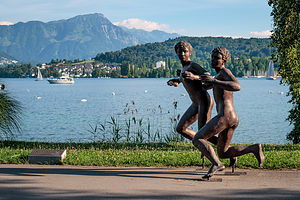 Outdoor art along the waterfront promenadeSwitzerland is not just alpine meadows, verdant pastures, flower-filled window boxes, and cowbells, so we figured it was about time we visited one of its cities, to see how the other half lived.
Outdoor art along the waterfront promenadeSwitzerland is not just alpine meadows, verdant pastures, flower-filled window boxes, and cowbells, so we figured it was about time we visited one of its cities, to see how the other half lived.
We chose Lucerne (population 81,000), just a half hour drive from Gimmelwald (population 120), -- but seemingly a world away. It is known for its beautiful Altstadt (Old Town) with colorful houses, waterfront promenades, covered bridges, sunny squares, and medieval architecture.
We found camping at Camping International Lido, across the street from Lido Beach, and just a mile and a half walk along the waterfront promenade to the Old Town.
 KapellbruckeAfter settling into our campsite, we walked across the street to the grassy beach on Lake Lucerne. We could have paid 7 francs to go to the official Strandbad Lido, a lakefront park with a heated pool, playground, volleyball court, and beach, but we thought the free beach right next door suited our needs just fine.
KapellbruckeAfter settling into our campsite, we walked across the street to the grassy beach on Lake Lucerne. We could have paid 7 francs to go to the official Strandbad Lido, a lakefront park with a heated pool, playground, volleyball court, and beach, but we thought the free beach right next door suited our needs just fine.
It was a Saturday, so the beach was full of young Lucernians (if that is a word) recreating. Most of them were under 30, probably because those with children were enjoying the facilities at the Strandbad Lido. Even the statues along the promenade were young. We old folks spent a relaxing afternoon swimming and people watching.
Later that afternoon we walked the mile and a half along the lovely waterfront promenade to Lucerne’s Altstadt, the colorful Medieval Old Town that the city is famous for.
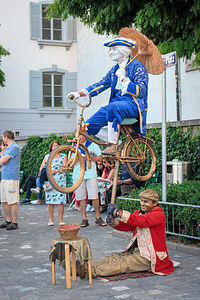 Lucerne street performersWhen we got to town, we continued along the waterfront to the Kapellbrucke (Chapel Bridge), the iconic covered wooden bridge that runs diagonally across the Reuss River. It is Lucerne’s most photographed landmark. Originally built in 1333, it was completely rebuilt and restored in 1993 after a devastating fire. Although damaged a bit by the fire, there are still more than a hundred 17th century pictorial panels hanging from the roof rafters, depicting scenes from the town’s history.
Lucerne street performersWhen we got to town, we continued along the waterfront to the Kapellbrucke (Chapel Bridge), the iconic covered wooden bridge that runs diagonally across the Reuss River. It is Lucerne’s most photographed landmark. Originally built in 1333, it was completely rebuilt and restored in 1993 after a devastating fire. Although damaged a bit by the fire, there are still more than a hundred 17th century pictorial panels hanging from the roof rafters, depicting scenes from the town’s history.
Next to the Kapellbrucke is the octagonal Wasserturm, a 13th-century, 110-foot high water tower that was once part of the town’s fortifications.
After crossing the bridge, we continued along the southern bank of the Reuss River to a plaza where street performers gathered. My favorite was a gold-covered peasant holding up a brightly-clad aristocrat on a bicycle. I don’t know how they did it! Of course, my engineer husband later explained it to me, giving away the illusion.
After passing the 17th century Jesuit Church, with its double onion-domed towers, we crossed back over the river along Lucerne’s second covered bridge - the Spreuerbrucke. Built in 1408, this bridge also has artwork in its rafters, but of a more macabre theme. Beneath the roof, for all sinners to see while passing beneath, are 45 triangular panels depicting the Dance of Death, known in German as a Totentanz.
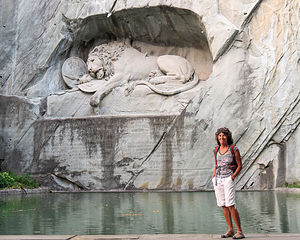 Lolo beating the hordes to the Lion MonumentWe couldn’t leave the Altstadt without visiting Lucerne’s famous Lion Monument, so we continued our self-guided tour up the hill to the Lowenplatz. As we approached the square, we passed a large tour group. We knew exactly where they were headed, so we picked up our pace to get there first. I am so glad we did, because for 3 minutes we had this beautiful, touching monument all to ourselves. As I was posing in front of it, I watched the army of tourists approach Herb from behind. “Just take the picture!” I urged through gritted teeth. He did, and not a moment too soon, as we were immediately engulfed by hordes of tourists.
Lolo beating the hordes to the Lion MonumentWe couldn’t leave the Altstadt without visiting Lucerne’s famous Lion Monument, so we continued our self-guided tour up the hill to the Lowenplatz. As we approached the square, we passed a large tour group. We knew exactly where they were headed, so we picked up our pace to get there first. I am so glad we did, because for 3 minutes we had this beautiful, touching monument all to ourselves. As I was posing in front of it, I watched the army of tourists approach Herb from behind. “Just take the picture!” I urged through gritted teeth. He did, and not a moment too soon, as we were immediately engulfed by hordes of tourists.
Having nabbed the rare solo shot in front of the Lion, we sat on a bench and took time to admire this truly touching sculpture of a dying lion, carved into the limestone cliff. It was created in 1820, as a memorial to the Swiss soldiers who died protecting King Louis XVI during the French Revolution. Mark Twain once called it the “saddest and most moving piece of rock in the world.”
On the way back to the waterfront, we passed another one of Lucerne’s beautiful churches - the Hofkirche, an 8th-century Benedictine monastery built in the 1630’s. This twin-towered church is considered the most important Renaissance church in Switzerland.
The walk back along the waterfront promenade in the evening light was enchanting.
Day 2 - Mount Pilatus Golden Round Trip
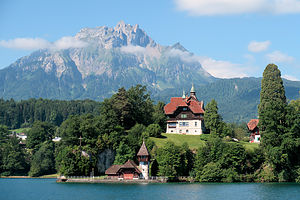 First leg of Golden Round Trip - cruise along Lake LucerneFrom everything we read, the single must-do tour in the Lucerne area is the Goldene Rundfahrt (Golden Round Trip) to the summit of Mount Pilatus, the iconic mountain that rises above Lake Lucerne. The trip, which costs 77 francs, is a multi-leg adventure with various means of transport, including a lake steamer, a cogwheel railway, a cable car, and a bus.
First leg of Golden Round Trip - cruise along Lake LucerneFrom everything we read, the single must-do tour in the Lucerne area is the Goldene Rundfahrt (Golden Round Trip) to the summit of Mount Pilatus, the iconic mountain that rises above Lake Lucerne. The trip, which costs 77 francs, is a multi-leg adventure with various means of transport, including a lake steamer, a cogwheel railway, a cable car, and a bus.
We started our journey, or “Golden Fart,” as Herb kept calling it, by walking to the nearby ferry dock by Lido Beach. From there, we boarded a beautiful lake steamer, which took us an a very scenic one-hour cruise across Lake Lucerne to the town of Alpnachstad.
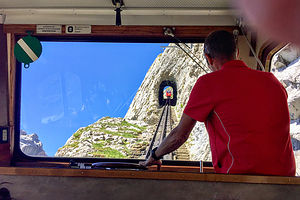 2nd leg of Golden Round Trip - cogwheel railwayUpon disembarking in Alpnachstad, we hopped aboard a cogwheel railway, famous for being the steepest in the world, with gradients up to 48%. This railway has been in action since 1889, which I have to admit made me a little nervous. For 40 minutes, we were transported through alpine meadows and forests, up steep rock faces, and through four tunnels to the summit of Mount Pilatus, 7,000 feet above sea level.
2nd leg of Golden Round Trip - cogwheel railwayUpon disembarking in Alpnachstad, we hopped aboard a cogwheel railway, famous for being the steepest in the world, with gradients up to 48%. This railway has been in action since 1889, which I have to admit made me a little nervous. For 40 minutes, we were transported through alpine meadows and forests, up steep rock faces, and through four tunnels to the summit of Mount Pilatus, 7,000 feet above sea level.
Now it was free time to spend as much time as we liked exploring the summit.
We stopped first to take a peek at the beautiful Hotel Pilatus-Kulm, built in 1890, a year after the cogwheel railway started scooting tourists up the mountain. The views from the rooms and Queen Victoria dining room must be amazing. We, however, satisfied ourselves with peanut butter and jelly sandwiches on the sun terrace.
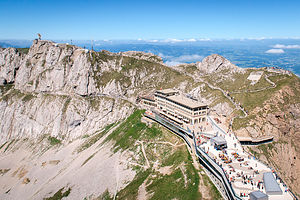 View of Pilatus-Kulm Hotel from EselThere are several hiking trails to various viewpoints. We started with the short walk up the Esel trail to the second highest point on Mount Pilatus - don’t worry, we would get to its highest later. From Esel, there was a wonderful view of the Hotel, Lake Lucerne, and the surrounding mountain peaks.
View of Pilatus-Kulm Hotel from EselThere are several hiking trails to various viewpoints. We started with the short walk up the Esel trail to the second highest point on Mount Pilatus - don’t worry, we would get to its highest later. From Esel, there was a wonderful view of the Hotel, Lake Lucerne, and the surrounding mountain peaks.
The whole while we were up there, we heard the haunting sound of a Swiss alphorn. We weren’t sure where it was coming from, but it certainly enhanced the experience.
 View from atop the Tomlishorn of Mt. PilatusNext, we took the longer and slightly rougher trail for about a mile past the Hotel to the Tomlishorn, the highest point and actual summit of Mount Pilatus. So many mountains in Switzerland end with “horn” because of their horn-like shape. Needless to say, the views from here were breathtaking as well.
View from atop the Tomlishorn of Mt. PilatusNext, we took the longer and slightly rougher trail for about a mile past the Hotel to the Tomlishorn, the highest point and actual summit of Mount Pilatus. So many mountains in Switzerland end with “horn” because of their horn-like shape. Needless to say, the views from here were breathtaking as well.
Back at the Hotel terrace, we tested out their comfy lounge chairs a while before starting on the next leg of our journey.
Satisfied that we had conquered Mount Pilatus, we boarded a gondola, which swept us along on a scenic aerial ride back down to the town of Kriens.
From there we walked to the bus stop and embarked on the least glamorous leg of our journey - the #1 bus back to Lucerne.
Description
 Twin onion-domed towers of the Jesuit ChurchLucerne is a small city in central Switzerland, known for its colorful Altstadt (Old Town) and preserved medieval architecture. The Altstadt, with its colorful houses, waterfront promenades, covered bridges, and sunny squares, lies on the east side of the River Reuss, an outlet to Lake Lucerne. Majestic Mt. Pilatus looms above the lake’s western shore.
Twin onion-domed towers of the Jesuit ChurchLucerne is a small city in central Switzerland, known for its colorful Altstadt (Old Town) and preserved medieval architecture. The Altstadt, with its colorful houses, waterfront promenades, covered bridges, and sunny squares, lies on the east side of the River Reuss, an outlet to Lake Lucerne. Majestic Mt. Pilatus looms above the lake’s western shore.
Sights in the Altstadt include:
- Kapellbrucke (Chapel Bridge), Lucerne’s best-known landmark, is a covered wooden bridge that runs diagonally across the Reuss River. Originally built in 1333, it was completely rebuilt and restored in 1993 after a devastating fire. Although damaged a bit by the fire, there are still more than a hundred 17th century pictorial panels hanging from the roof rafters, depicting scenes from the town’s history. Next to the Kapellbrucke is the octagonal Wasserturm, a 13th-century, 110-foot high water tower. It was once part of the town’s fortifications.
- Spreuerbrucke is Lucerne’s second covered bridge. Built in 1408, this bridge also has artwork in its rafters, but of a more macabre theme. Beneath the roof, for all sinners to see while passing beneath, are 45 triangular panels depicting the Dance of Death, known in German as a Totentanz.
- The Jesuit Churchon the Reuss’s left bank was Switzerland’s first church in the Baroque style. Built between 1666 and 1677 it can be easily recognized by its two distinct onion-domed towers. In 1750, its interior was updated to the Rococo style
- The Lion Monumentis a 10-meter long sculpture of a huge dying lion, carved into the limestone cliff in the Lowenplatz, just north of the Altstadt. It was created in 1820, as a memorial to the Swiss soldiers who died protecting King Louis XVI during the French Revolution. Mark Twain once called it the “saddest and most moving piece of rock in the world.”
- The Museggmauer (Town Walls)run along the north side of the Altstadt. Built between 1350 and 1408, each of the nine towers was constructed in a different style. Four of the towers can still be climbed today for views of the city and the lake. The Zyt tower houses the city’s oldest clock, built in 1535. It asserts its dominance by chiming one minute before all the other clocks in the city
- The Hofkirche is an 8th-century Benedictine monastery. Built in the 1630’s, this twin-towered church is considered the most important Renaissance church in Switzerland. Recitals of the church’s famous organ are held in the summer.
- The Museum Sammlung Rosengartshowcases the Post-Impressionist collection of Angela Rosengart, an art collector and friend of Pablo Picasso. The collection features the works of more than twenty 19th and 20th century artists, such as Klee, Monet, Cezanne, Chagall, Braque, Matisse, Miro, and Kandinsky
- The Verkehrshaus der Schweiz (Swiss Transport Museum), just east of the city center, is devoted to Switzerland’s proud transport history - from automobiles, to ships, to railway locomotives, to aircraft, to rockets. An entire exhibit explains how construction of rail tunnels through the mountains
- The Strandbad Lidois a lakefront park with a heated pool, playground, volleyball court, and lakefront beach. Admission is 7 francs. Right next to the park, there is a lovely grassy beach that is free, where the locals like to lounge and swim.
Mount Pilatus Golden Round Trip
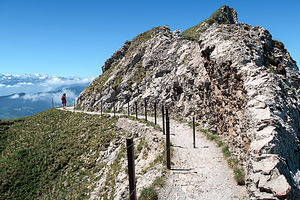 Approach to TamlishornWhen in Lucerne, one should really not miss the classic Goldene Rundfahrt (Golden Round Trip) to the summit of Mount Pilatus, the iconic mountain that rises above Lake Lucerne.
Approach to TamlishornWhen in Lucerne, one should really not miss the classic Goldene Rundfahrt (Golden Round Trip) to the summit of Mount Pilatus, the iconic mountain that rises above Lake Lucerne.
The trip begins with a scenic, hour-long trip on a lake steamer from Lucerne to Alpnachstad. From there you board the steepest cogwheel railway in the world, with gradients up to 48%, for a 40 minute ride through alpine meadows and forests, up the steep rock face, and through four tunnels to the summit of Mount Pilatus, 7,000 feet above sea level. Spend as long as you like on the summit, taking one of the short hikes to various viewpoints, dining at one of its restaurants, or just lounging in one of the deck chairs on the terrace. When you are ready to leave, the summit cable cars will bring you down to Kriens where bus #1 will bring you back to Lucerne.
The cost of the trip is 72 francs per person.
- ‹ previous
- 14 of 17
- next ›
Lucerne location map in "high definition"
Javascript is required to view this map.
